Interview with Singer Reimagined Co-Founder and CEO Marco Borraccino: History, Present (the excellent Divetrack), and Future
During Watches & Wonders in April, we met Singer Reimagined co-founder and CEO, Marco Borraccino in his showroom at the Beau Rivage hotel in Geneva.
We were warmly welcomed as we entered the room. Several exhibition timepieces were already laid out on a few trays on the coffee table in the middle of the room. We sat in comfortable brown armchairs around the table and, with a loupe in one hand and a glove on the other and leaning forward we attentively admired the watches and their movements while Marco described them to us.
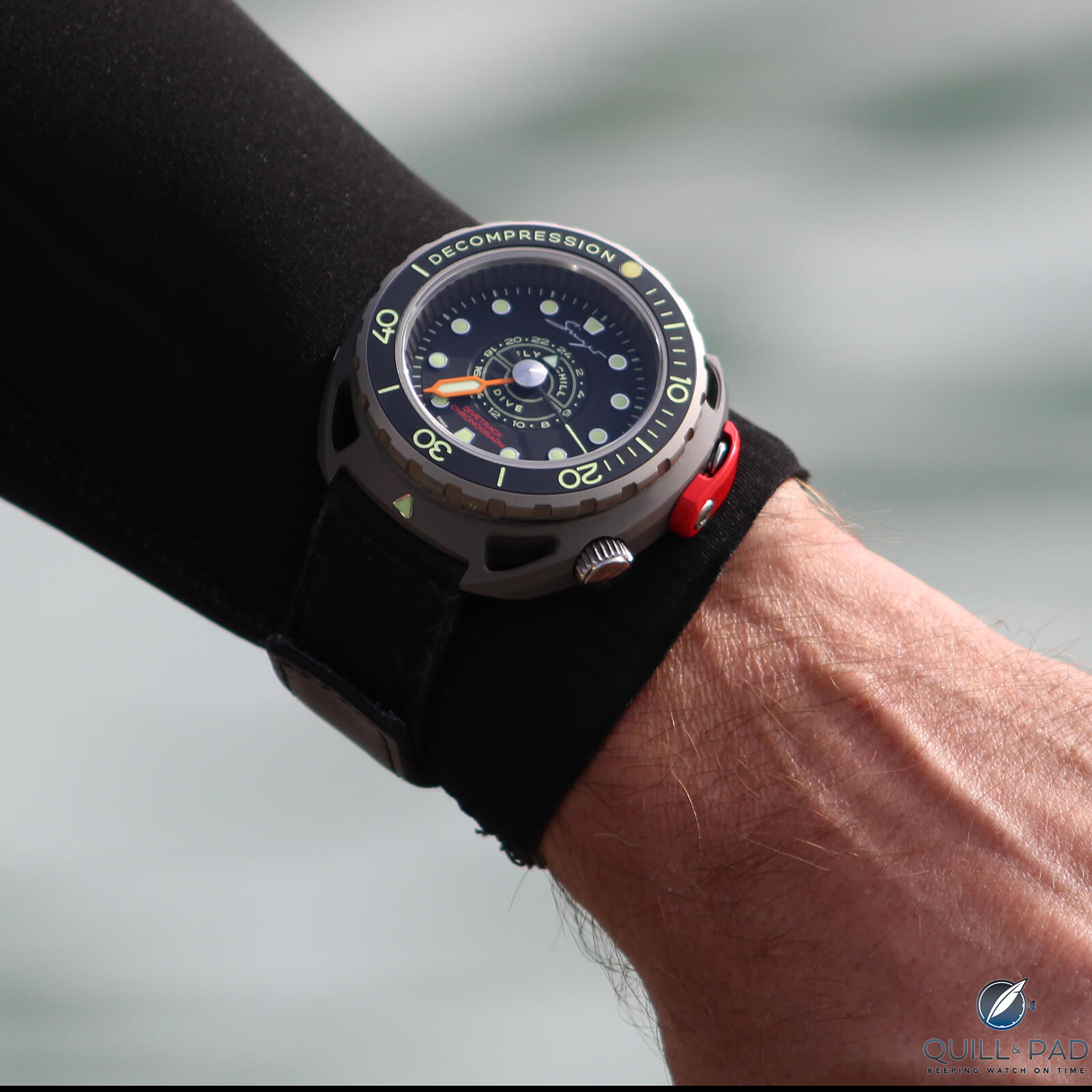
Singer Reimagined Divetrack
Amongst them, commanding our attention was the Divetrack, Singer Reimagined’s latest creation, a mechanical diver chronograph that reimagines the functionality and purpose of a modern Diver’s watch.
Before taking leave from Marco that afternoon, we agreed to meet again for an interview. Few weeks later, I visited him at his Atelier in Geneva, a three-level loft in the Carouge area. The lower level, where we were received, looked the size of a basketball court.
Large posters of watches were filling the white walls; minimal furniture was arranged throughout the room leaving several empty spaces; and generous light was entering through the large windows at the front of the room. It was all neatly organized giving the impression of being the result of careful interior designing.
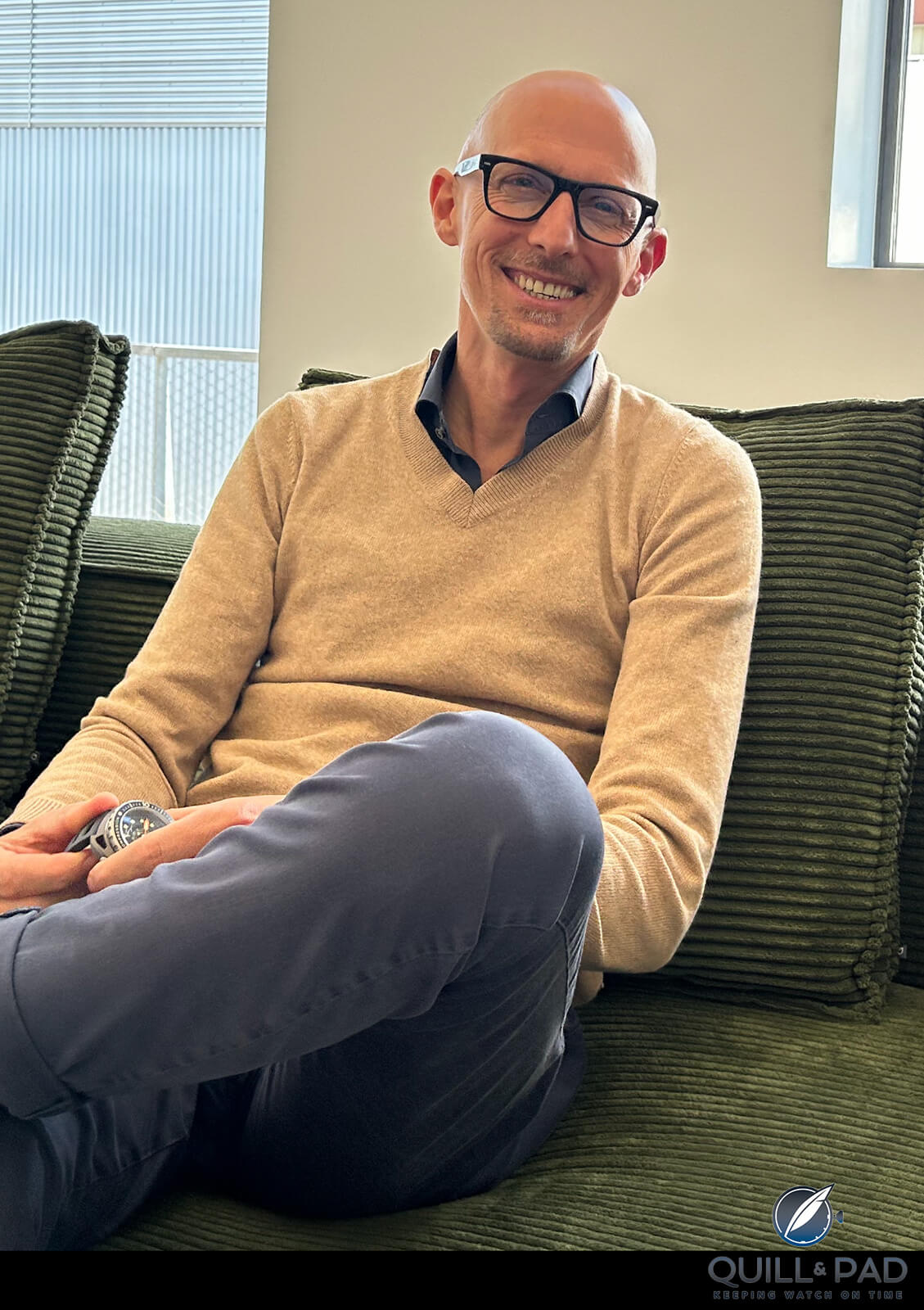
Marco Borraccino, CEO and co-founder of Singer Reimagined
Borraccino began working on Singer Reimagined’s first model back in 2014. He launched the company and his first model, the Track1 in 2017, which won the Prize for the Best Chronograph at the 2018 Grand Prix d’Horlogerie de Genève (GPHG), with the Track 1 model. It is powered by the innovative AgenGraph movement.

AgenGraph chronograph movement
Since then, three more collections of timepieces have been added to the Singer Reimagined portfolio: 1969, FlyTrack, and in 2024 the Divetrack.
————————————————————————————————————–
—————————————————————————————————–
Interview
SG: During this year’s Geneva Watch Week, in April, you unveiled your latest creation, the Divetrack, a mechanical diving chronograph, a first of its kind. What prompted you to embark on this project?
MB: The fundamental idea behind Singer, ever since we created the company, has been to reimagine watchmaking icons. In fact, we started with the reimagining of what is perhaps the most important icon in watchmaking, namely the chronograph.
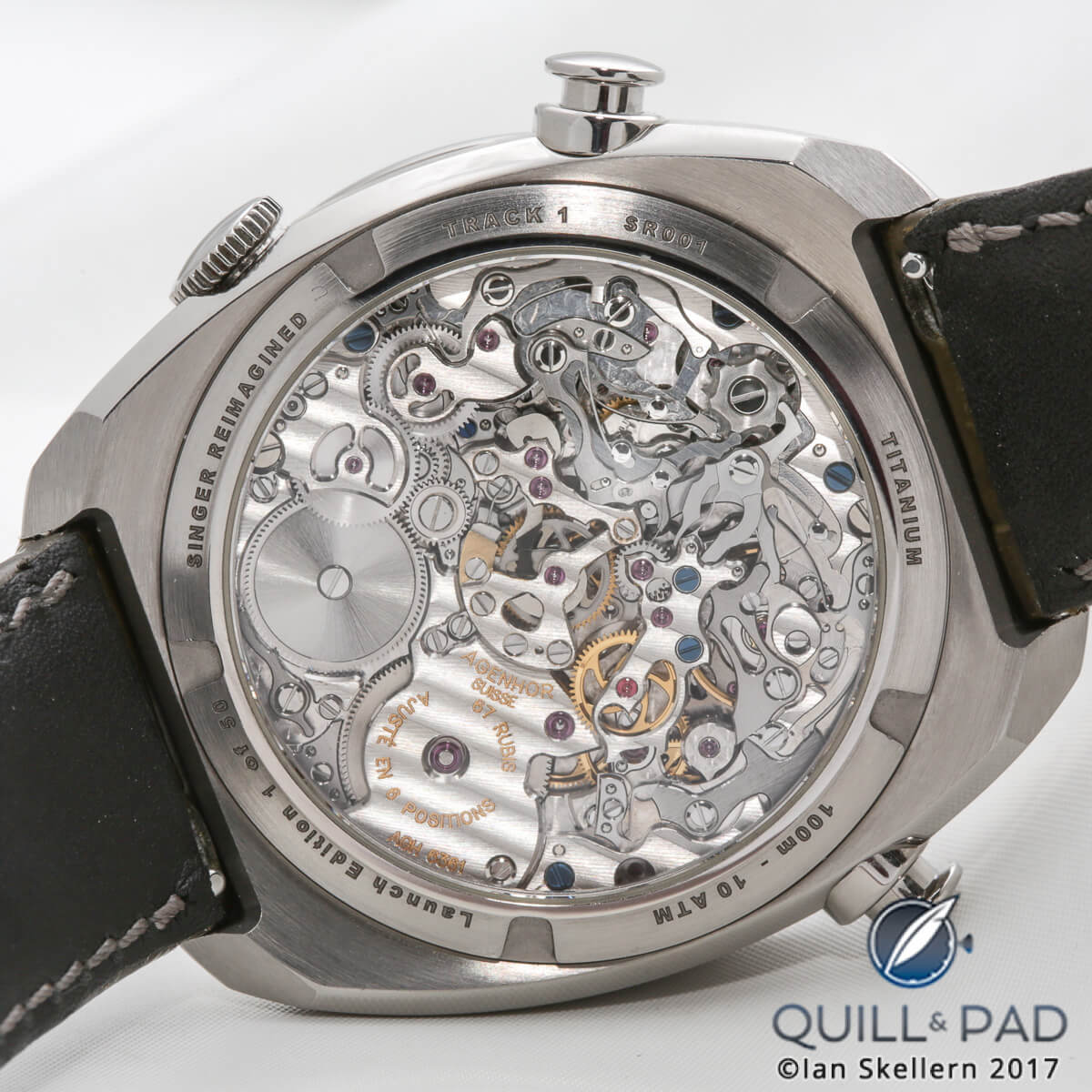
View through the display back of the Singer Reimagined Track1 to the AgenGraphe movement within
This led to the development of an innovative movement, the AgenGraphe, which enabled the central display of the chronograph functions and the peripheral view of the hours and minutes.
The next idea, which actually came to me in parallel with the idea of the new chronograph, was that thanks to the AgenGraph, we could do things that were unthinkable with other movements! So, at the same time when the development project for the AgenGraph was materializing, about ten years ago, I was already asking myself how our movement could improve the functionality of another important icon in watchmaking, the Diver’s watch.
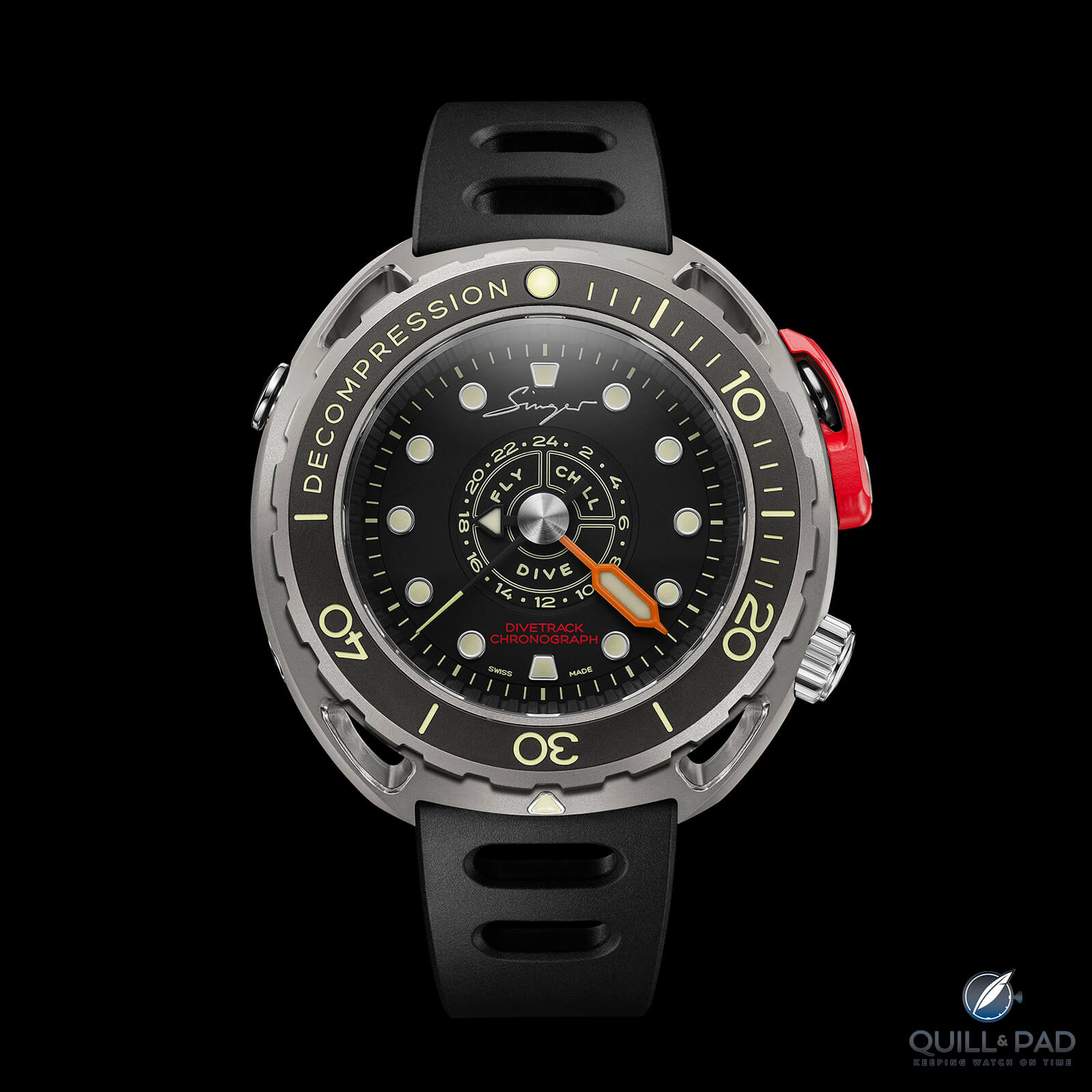
Singer Reimagined Divetrack
This is when I pictured in my mind the Divetrack, a mechanical diving chronograph, a watch tool that could be functional and relevant to the whole diving experience: before, during, and after the dive.
—————————————————————————————————–
—————————————————————————————————–
SG: In the beginning, you had the idea of how to reimagine the chronograph but you were missing the movement that could support your design. How did the two come together?
MB: Let’s say that the two went almost in parallel. They went in parallel in the sense that I designed the watch with the chronograph functions in the center and the hours at the periphery, believing that this was technically possible. But I had no movement for it.
I was then lucky to meet Jean-Marc Widerrecht, founder of Agenhor, who had already conceived a central chronograph. I remember very well the day when I showed Jean-Marc my drawings of the chronograph, for the first time. We were having lunch at HEAD university, here in Geneva, following a meeting of the Watch Design Scientific Committee of which he was a member and I was the chair.
While chatting, Jean-Mac asked me what else I was doing besides teaching at the university, and so I explained to him that I was working on the concept of a chronograph with central hands.
Well…at that point Jean-Marc’s expression changed completely, showing first surprise and then intrigue; he became very curious to know how I had come to imagine such a watch and who was making the movement for it. Apparently, he was working on it at the time, or had been working for a while on engineering a movement with the five central hands, hours and minutes plus three chrono hands.
The rest is history, as they say. A few days later, I showed him all my drawings and design details, we laid out the preliminary plans of his movement, and we realized that by further developing his movement we could adapt it to my design.
SG: What feature of the Divetrack are you most proud of?
MB: I am proud of the fact that the Divetrack goes beyond everything that has been done so far. It delivers a complete diving experience .
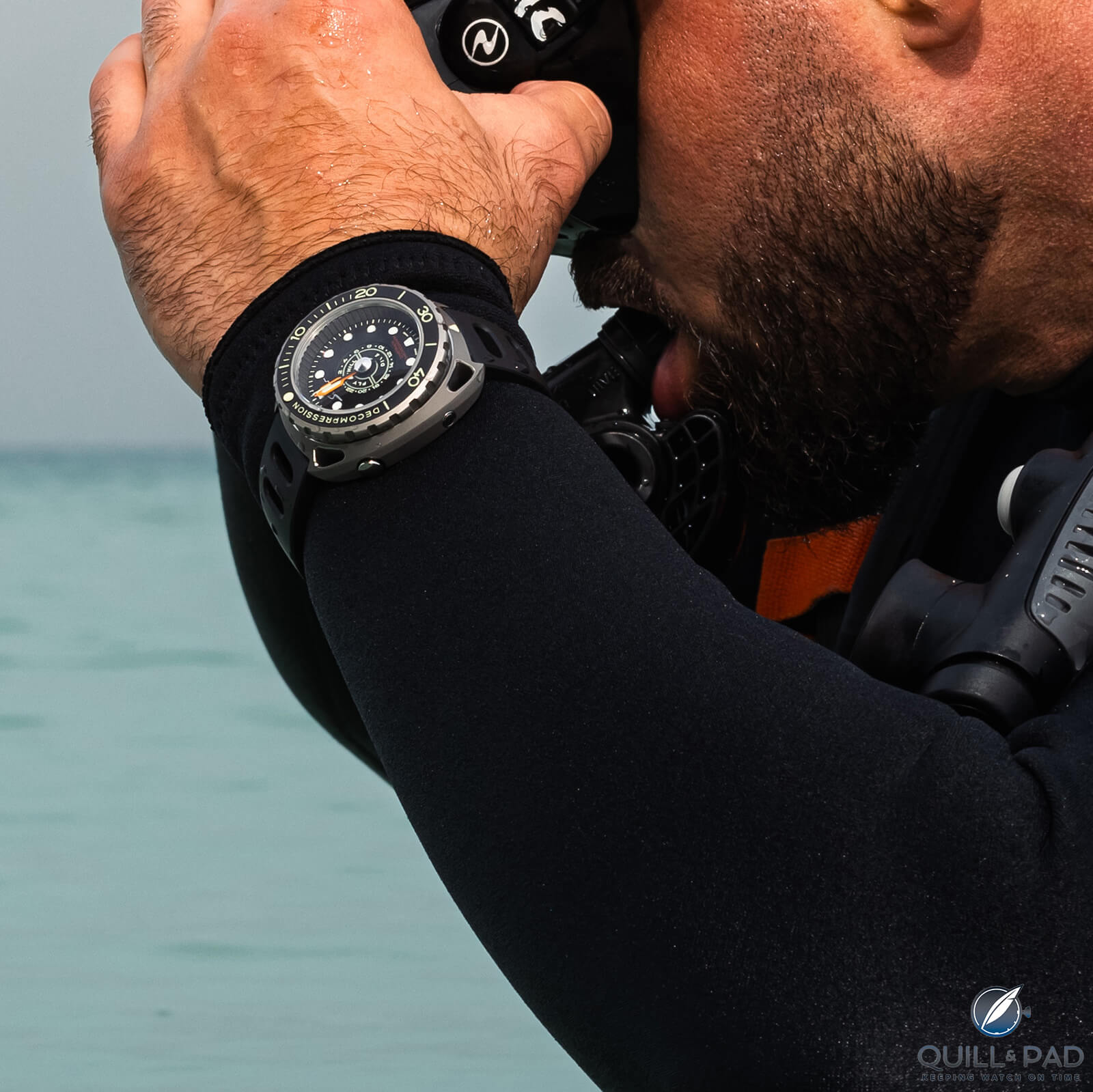
Singer Reimagined Divetrack
MB: Modern Diver’s watches offer limited functionality to divers. They no longer make sense, because when you dive, you will wear a diving computer on your wrist. On the other hand, the Divetrack allows you to display information during the dive, as well as information about your surface intervals, that is between dives, and after the dive, for example before boarding a plane for your return flight home.
No one has ever thought before of a watch to monitor this type of information which, as you know, is crucial for the diver‘s safety and is one of the first things you learn when you start diving. The Divetrack can also operate as a backup to the computer to calculate the descent times and the decompression times as you ascend to the surface.
My goal was not to create a watch that goes to the most imaginable depth, because no one will ever go there. But to develop an instrument designed for an all-round immersion, an all-round diving experience.
—————————————————————————————————–
—————————————————————————————————–
SG: What are some of the challenges that you faced during the development of the Divetrack?
MB: The technical development of the Divetrack lasted five years. A key challenge we faced during this time was to achieve the 300 meters water resistance, which in reality is 375 meters, because you are required to add a 25% more depth, when you perform the tests to achieve ISO Standard certification.
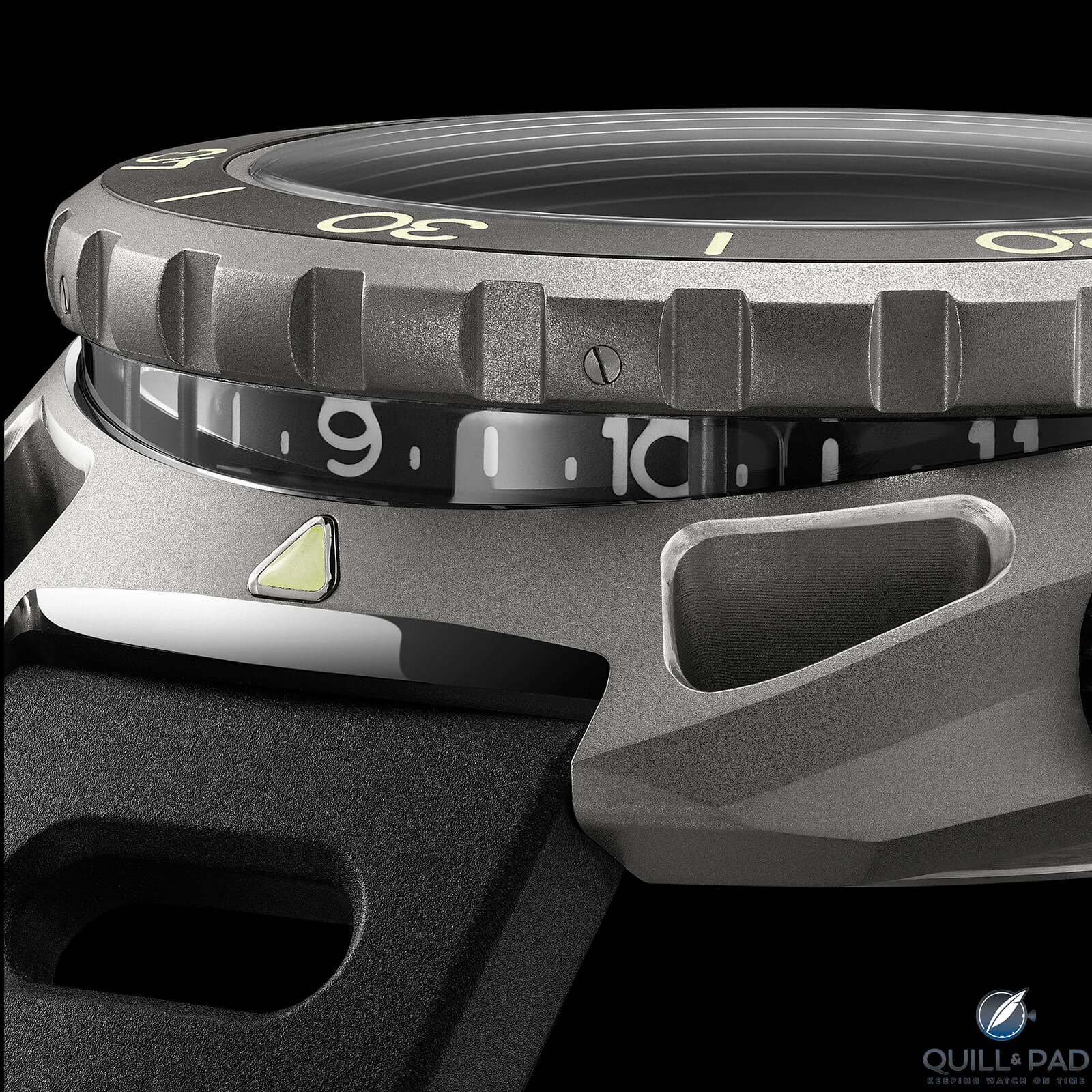
Singer Reimagined Divetrack time indication on caseband
The Grade 5 Titanium case of the Divetrack includes three sapphire crystals, the top one, the middle one in the carrure, and the bottom one, each measuring three millimeters in thickness. So, in total, you have almost a centimeter of sapphire in the case, which for a Diver’s watch is quite a challenge!
MB: In order to make the Divetrack resistant to water pressure and to the daily wear and tear it would be subjected to during its life as a Diver’s watch, we had to carefully study the behavior of the structure of the watch. We ran simulations using mechanical deformation software to see how the entire structure of the watch, including the glass, would deform or change in mechanical terms at different depths.
Based on these analyses, we then sized and designed all the elements, and we chose the materials, so as to optimize and achieve the desired structural integrity of the watch.
—————————————————————————————————–
—————————————————————————————————–
SG: Who is Singer’s typical client?
MB: We have been fortunate to generate new passions in customers who were not at all into haute horlogerie and the first purchase they made was a Singer timepiece, which is quite surprising. However, the vast majority of our clients are watch collectors who have the knowledge to understand why our watches are special.
From an aesthetic point of view, all the watches we make are somewhat inspired by a retro, vintage design. On a technological level, we have an excellent movement, a technology that is at the pinnacle of what is being done in watchmaking today. It is this mix of elements that makes the Singer product itself unique and interesting to collectors.
I put great effort into developing a brand identity that is constant and that is recognizable. And the feedback I have received so far from the market has been rewarding.

Singer Reimagined Flytrack Arabic
SG: How do you organize your day at work?
MB: As you can imagine, when you run a small business like ours, you need to become multitasking. My role is that of a CEO and, at the moment, I am also the COO of Singer. Professionally, I was born as a designer.
Most of my time is spent in organizing, managing people, coordinating suppliers and watchmakers. In watchmaking, your relationships with suppliers and all the stakeholders in the industry are the key to your success. You need to invest time in your network.
The plan now is that the company starts to develop and to structure itself in such a way that I can free myself up a bit and spend more time on strategy, on the creative part, and be less involved in the operational parts.
—————————————————————————————————–
—————————————————————————————————–
SG: In your view, how has the watchmaking industry evolved since you started in this industry?
MB: When I started, in 1999, I started in the more mainstream sector of watchmaking and was focused on the creation part.
I began having a bit more of a global vision of watchmaking when I moved from Panerai to working as a consultant for several brands. I was then able to weigh up a bit the different feedback from the brands. I was also dealing with a much larger network of suppliers.
If I fast-forward to today, in my opinion, there are quality problems with Swiss suppliers. A situation, it seems to me, that was not the case 10 years ago, or at least pre-COVID. Probably, the pandemic played a big part in this, because during this time many companies had to lay off qualified personnel. Following the pandemic, it became difficult to find a specialized workforce, because many people had converted to other professions and had left the industry.
Many brands already rely on suppliers from abroad. And frankly, neither I, nor you, nor anyone else could detect the qualitative difference between Swiss and non-Swiss supplies, in most cases. In fact, the opposite is often true.
The price you pay today for a medium-quality component in Switzerland is 3-4 times the price you would pay for a very high-quality component made in Japan or in China, for example. The materials are the same, the machines used are the same, but the labor costs are much lower. It is difficult to say how this trend will evolve in the future.
SG: Casting an eye into the future, where do you see the industry heading to in 5 years from now?
MB: This is an exercise that is honestly impossible. Even when discussing with my partners we always talk about 3-5-7 year business plans, but in today’s world, with all the existing uncertainties, for example the economic downtrends, the war in Ukraine, possible military conflicts in the middle east, making a projection for the next 6 months is difficult.
The feedback we got from Watches & Wonders last April was that, despite liking our watches a lot, and fantastic media coverage, the public and industry operators were uneasy about what was going to happen in the next few months. Investments and inventory stocks are all with the handbrake pulled. This is true for both independents and big brands.
At Singer, we have the advantage that being a small and agile manufacturer, if we can feel the business winds turning, we can react quickly, with relatively little inertia.
I am convinced that as long as you have a product that is delightful, meaningful, and of high quality, and produce relatively small volumes as we do, you are in a better position to adapt to market trends.

Singer Reimagined 1969 Bronze
SG: What is next for Singer Reimagined?
MB: There will be an extension of the 1969 collection, with a Bronze version, at the beginning of June (Fig.7), as I want to create a more complete offer for this collection; one that is more digestible in aesthetics and functional terms than our earlier collections. For the 1969, between the chrono and the timer, you have two models that are wearable every day, that are small in size therefore more in line with current trends, and they retain all the innovative technological content that is typical of Singer.
Apart from that, we will have some exciting news for our customers at the end of the year. I do not wish to comment on them now, but I can tell you that they will relate to something interesting from both a product and a market positioning point of view, while keeping the codes and the philosophy of the brand.
For more information, please visit https://singerreimagined.com/
You might also enjoy:
Singer Reimagined Divetrack: The World’s Best Mechanical Divers’ Watch – Bar None!
The Diving Bezel: The Most Versatile Watch ‘Complication,’ Even If You’re Not A Diver

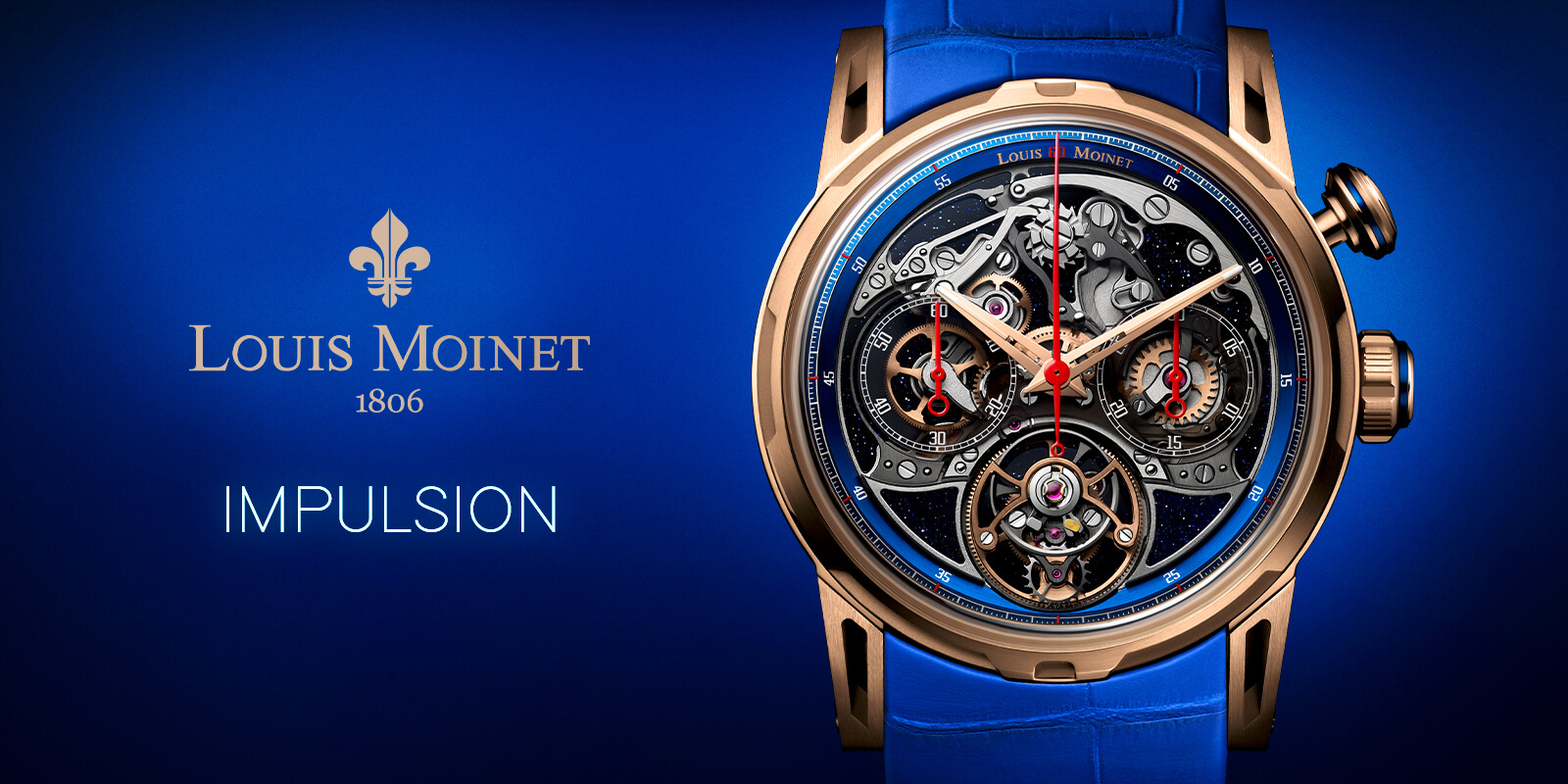
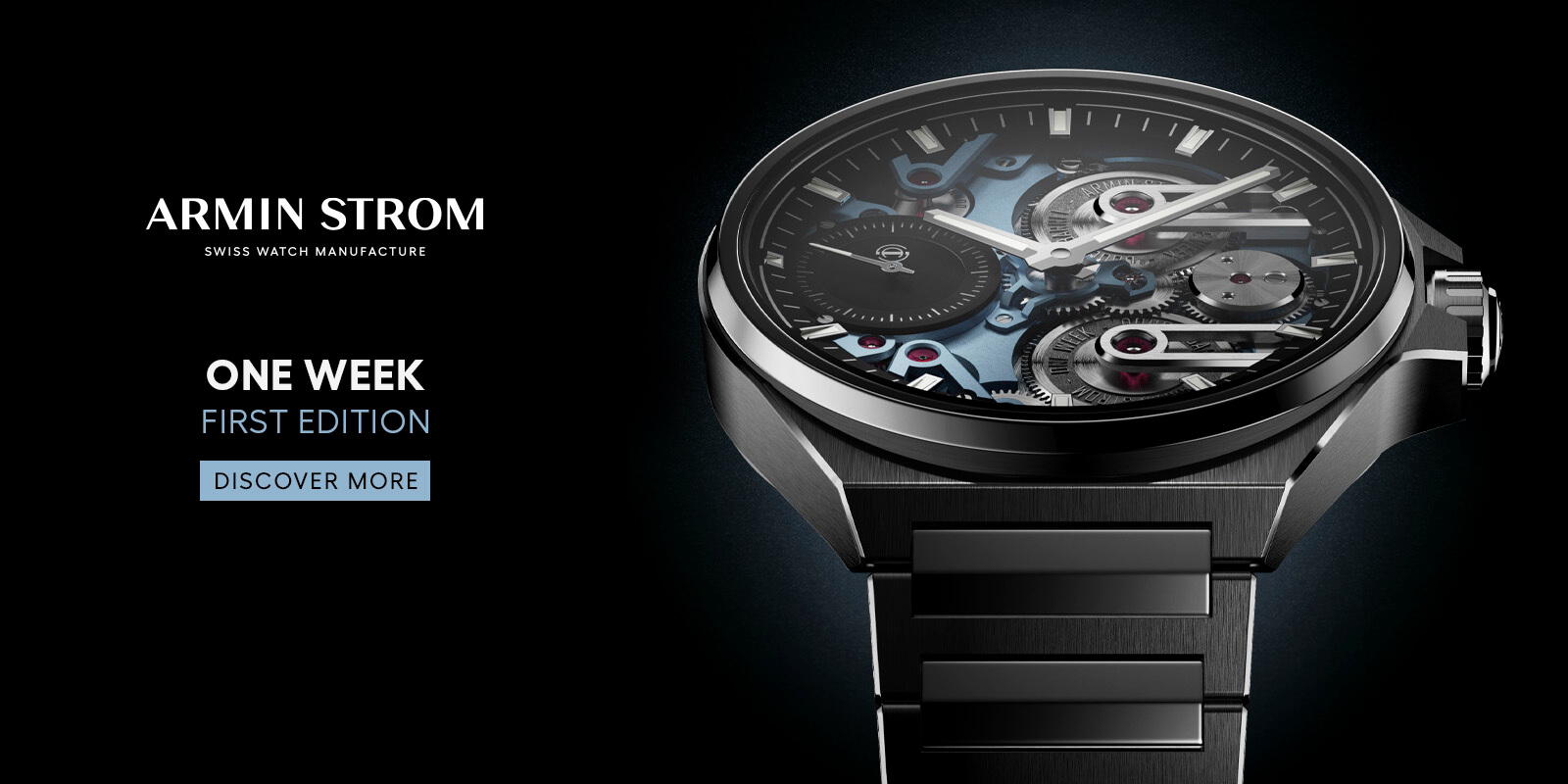
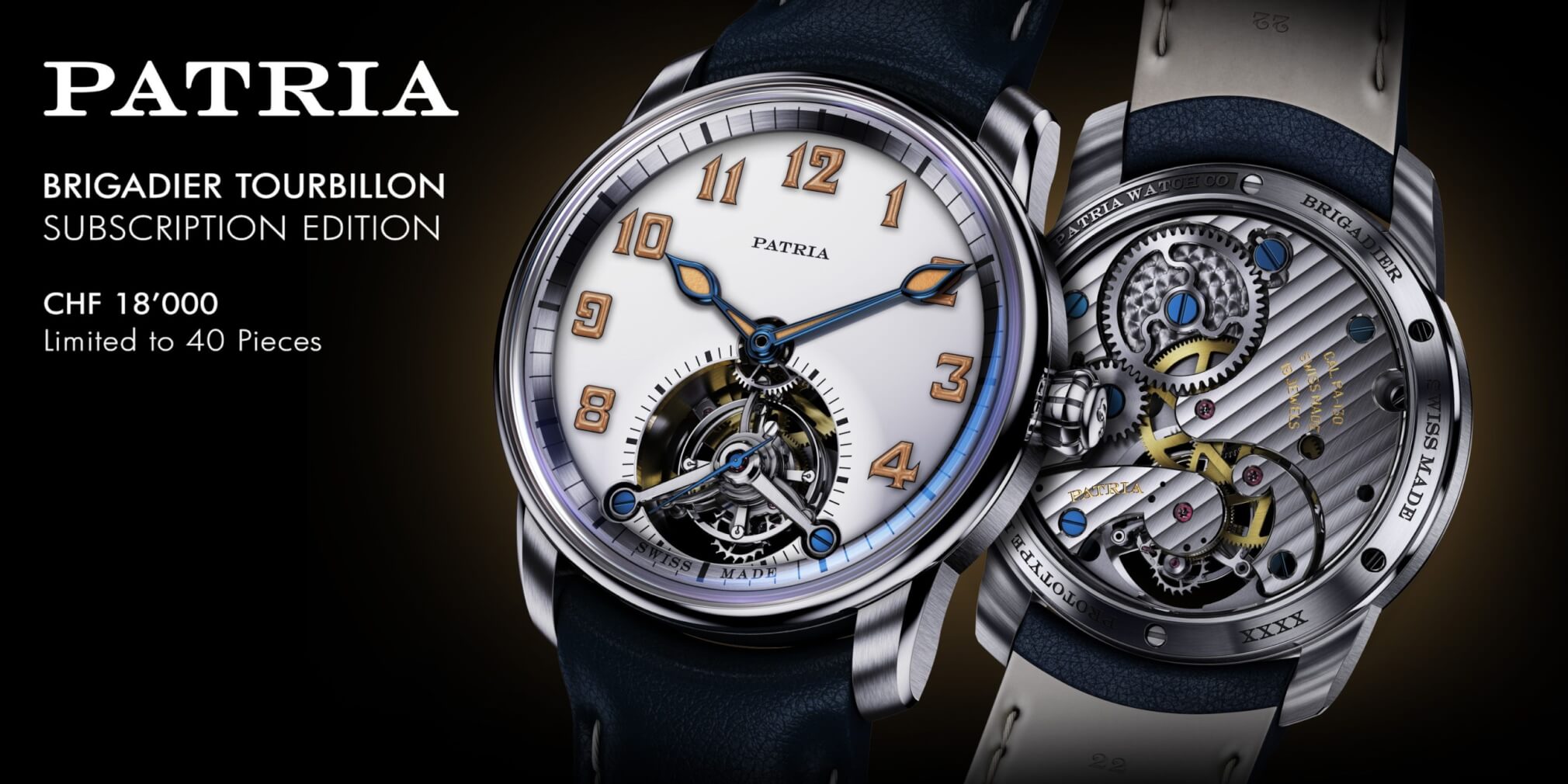


Leave a Reply
Want to join the discussion?Feel free to contribute!